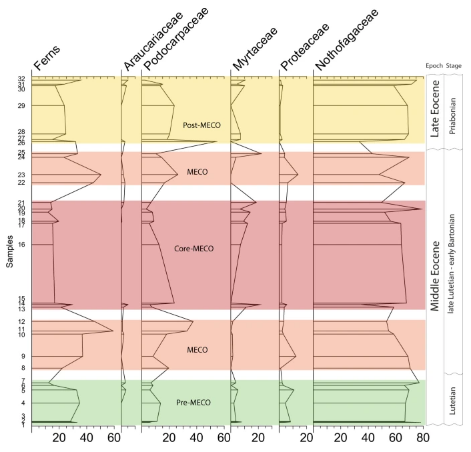
Mammuthus primigenius, Royal British Columbia Museum. From Wikipedia Commons
From Siberia to Alaska, mammoths were widespread in the northern hemisphere during the Last Ice Age and their remains inspired all types of legends. Their lineage arose in Africa during the late Miocene, and first appeared in Europe almost three million years ago. Eventually they dispersed to North America via Beringia, during the Middle Pliocene to Early Pleistocene. Their evolution during the Pleistocene is usually presented as a succession of chronologically overlapping species. M. meridionalis (southern mammoths) arose about 2–1.7 million years ago and was replaced by M. trogontherii (steppe mammoths), which evolved in eastern Asia around 2–1.5 million years ago. Although the relationship among these taxa are uncertain, the prevailing view is that M. columbi (Columbian mammoths) must have arisen from M. trogontheri, which must also be the ancestor of the earliest known examples of M. primigenius (woolly mammoths). A new study by an international team of paleontologists and geneticists offers a glimpse into the origin and evolution of woolly and Columbian mammoth. They used genomic data more than one million years old. So far, the oldest genomic data recovered were from a horse specimen dated to 780–560 thousand years ago.
The researchers recovered genome data from three Early-Middle Pleistocene mammoth molars preserved in Siberian permafrost. The samples were recovered by the late Andrei Sher (Russian Academy of Sciences, Moscow) from the well-documented Olyorian Suite of northeastern Siberia in the 1970s. The first specimen (referred to as ‘Krestovka‘) is morphologically similar to the steppe mammoth (originally defined from the Middle Pleistocene of Europe). It was discovered in 1973 in a cliff exposure along the right side of the Krestovka River. The second specimen (referred to as ‘Adycha’) was recovered in 1976 from a gravel bar in the Adycha River and shows M. trogontherii-like morphology. The third specimen (referred to as ‘Chukochya’) was found in 1971 in a riverbank on the right side of the Bolshaya Chukochya River, and has a morphology consistent with an early form of woolly mammot.

Krestovka specimen showing measurement positions: W = crown width, H = crown height, LL = lamellar length, ET = enamel thickness. From van der Valk et al, 2021
Analysis of the DNA suggested that two evolutionary lineages of mammoths inhabited eastern Siberia during the later stages of the Early Pleistocene. One of these lineages is represented by the Krestovka specimen (dated 1.65 Ma), and the second lineage comprises the Adycha specimen (dated 1.3 Ma) along with all Middle and Late Pleistocene woolly mammoths. The results also indicate that the Columbian mammoth is a product of admixture between woolly mammoths and a previously unrecognized ancient mammoth lineage, represented by the Krestovka specimen. This hybridization event took place around 420,000 years ago. The new findings indicate that before the hybridization event North American mammoths belonged to the Krestovka lineage. Previously, a DNA study of the complete mitochondrial genome of Columbian mammoths suggested that interbreeding between late Pleistocene taxa could serve as an indicator of major ecological events, including those surrounding the megafaunal extinctions.
The iconic woolly mammoth evolved into a cold-tolerant, open-habitat specialist through a series of adaptive changes like hair growth, and white and brown fat deposits. The study found that the genes related to these features were present in both the Adycha (87%) and Chukochya (89%) genomes. The findings are suported by the tooth shape of all these northern species that is adapted to grazing in a cold, open environment.
References:
van der Valk, T., Pečnerová, P., Díez-del-Molino, D. et al. Million-year-old DNA sheds light on the genomic history of mammoths. Nature (2021). https://doi.org/10.1038/s41586-021-03224-9
Laura Arppe, Juha A. Karhu, Sergey Vartanyan, Dorothée G. Drucker, Heli Etu-Sihvola, Hervé Bocherens. Thriving or surviving? The isotopic record of the Wrangel Island woolly mammoth population. Quaternary Science Reviews, 2019; 222: 105884 DOI: 10.1016/j.quascirev.2019.105884
Enk, J.; Devault, A.; Widga, C.; Saunders, J.; Szpak, P.; Southon, J.; Rouillard, J. M.; Shapiro, B.; Golding, G. B.; Zazula, G.; Froese, D.; Fisher, D. C.; MacPhee, R. D. E.; Poinar, H. (2016). “Mammuthus population dynamics in Late Pleistocene North America: divergence, phylogeography, and introgression”. Frontiers in Ecology and Evolution. 4. doi:10.3389/fevo.2016.00042.
Enk, J., Devault, A., Debruyne, R. et al. Complete Columbian mammoth mitogenome suggests interbreeding with woolly mammoths. Genome Biol 12, R51 (2011). https://doi.org/10.1186

